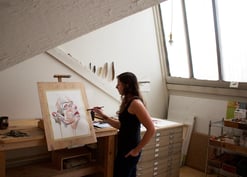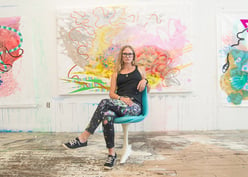Amanda Hill's diverse and expressive work showcases the beauty that can be found in unexpected places. With a lifelong passion for painting, she channels her creative determination towards a deep engagement with complex themes. Her practice often explores contrasts such as those between safety and vulnerability, natural and industrial landscapes, or the good and evil inherent in human nature. Drawing inspiration from both classical references and everyday elements, Amanda elevates overlooked or utilitarian details, like car parts or propane tanks, by reimagining them through vibrant color and form.
Working in both large-scale public art and intimate studio pieces, Amanda blends careful observation with experimentation, building compositions from her own reference photos, collages, and digital sketches. Her murals and paintings incorporate the human figure, engaging with narrative and the idea of what happens before and after a moment in time. Through this thoughtful process, she creates a compelling visual dialogue that reveals the quiet beauty in our surroundings.
Tell us about your work. What themes or messages do you hope to convey through your art?
A lot of my work is based on the idea of opposites and dichotomy. I'm experimenting with a concept from Latin, "Locus Amoenus" and "Locus Terribilis," which explores that dichotomy between an idealistic, nature-based place and what happens when something changes, turning it into something sinister and evil.
I also draw inspiration from things that might be considered mundane. It's the things that don't always make people stop and say, "Oh, that's beautiful," that I find really interesting. There's something powerful about these moments of observation where you find life in the unique shapes and colors of something overlooked. In these studies, I enjoy playing with really bright colors as well as subdued colors.
Tell us about your process.
I work within series, exploring one idea at a time. I usually paint from reference photos, most of which I take myself or collage together, often from pictures I take when I travel.
The painting process itself is experimental. I may start with a vision, but then I'll start painting, and it will change. I might change the sizing of something because it doesn't feel right. It's important to let go of that fear of starting over and embrace trial and error to understand what's going on in your painting.
Is there a unique part of your process you're currently exploring?
Yes, recently I've started to transition the digital work I do for murals to my canvas work. I'll create something on my iPad, which I typically do to plan a mural, but now I'm experimenting with seeing how I can take that digital creation and put it on a canvas rather than a wall. It has been an interesting process.
What is your advice for combating creative blocks? Are there any specific strategies you use to reignite your creativity?
When I face a creative block or feel stressed out, I do color studies. They allow me to make very basic decisions of color and shape, rather than getting involved in the details of a different piece. When I come into the studio, I usually make a cup of tea, sit for a little bit, look at whatever I'm working on, and just assess what I need to do next.
Tell us about your journey to becoming a professional artist.
My journey was sort of roundabout. I’ve been making art since I was little, but I actually stopped painting for about five years while I was getting a graduate degree in nonprofit management. After I started to get involved in different art groups again, I realized I didn't want to be doing administration; I wanted to be the one painting on the wall or on a canvas. So, I eventually found my way back to doing art and trying to do it full-time.
In terms of my mural work, I’ve always been interested in large-scale painting. I painted my first mural on paper in eighth grade on my mom's living room floor. Later, in my early twenties, I apprenticed in Philadelphia with a mural group, and that sort of just sealed it for me. I knew then that I not only wanted to have a small studio practice but a larger one as well.
How do you define success as an artist?
My idea of success as an artist has changed over time. It's not necessarily all monetary, though that definitely helps. It's really about creating something that you are proud of. It's important to prioritize what speaks to you rather than creating work for someone else.
What advice do you have for artists who are beginning to build their careers?
First, you just have to keep going. There are going to be bumps along the way, and it's going to feel difficult, but it's your perseverance that's going to get you through.
Also, surround yourself with a network of different artists and people who you can learn from. Networking isn't necessarily formally getting coffee; it might be who you talk to at a party or on the street, so don't close yourself off from those conversations.
Finally, don't edit yourself. If you have an idea, don't just think about it and say, "Oh, well, that's dumb. Why would I do that?" You have to shove that aside, get over whatever that fear is, and dive right in.
To see more featured TurningArtists, return to our blog. To get Mini Mukherjee's art in your space, set up a free consultation with an Art Advisor here!




_VSCO.jpg?width=332&height=177&name=TMoss_Continuum%20Sliver%20copy%20(1)_VSCO.jpg)

